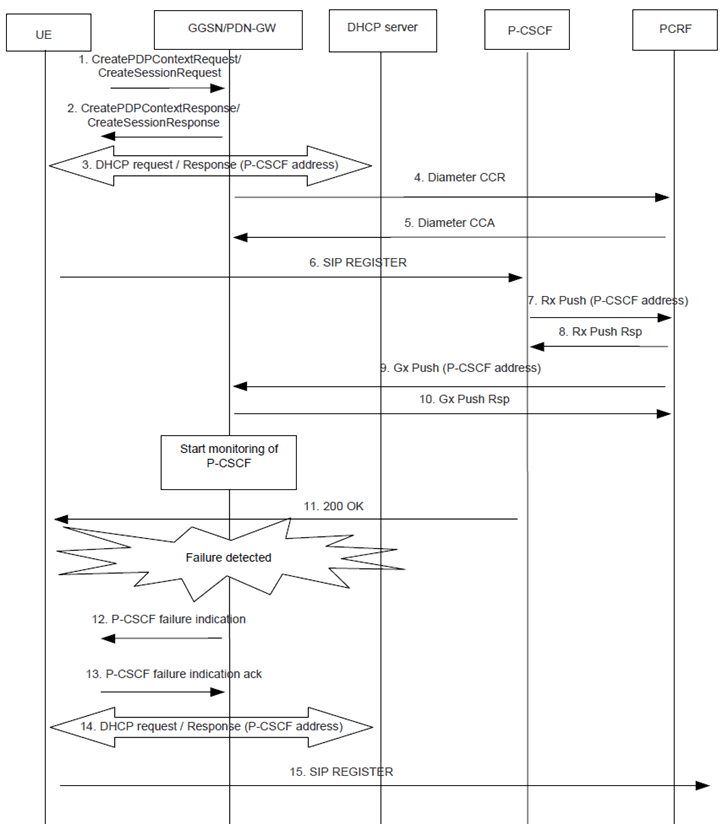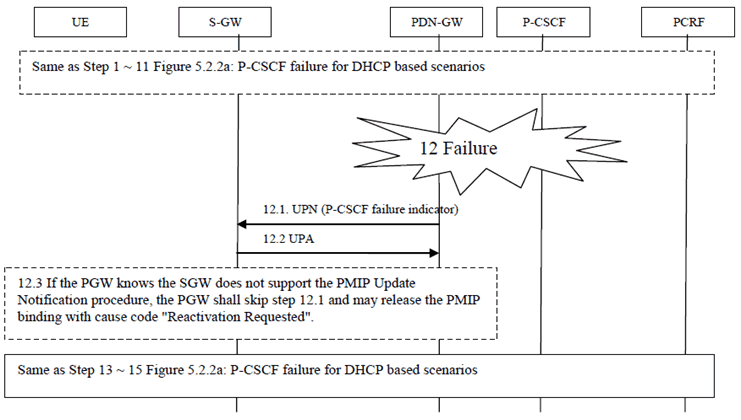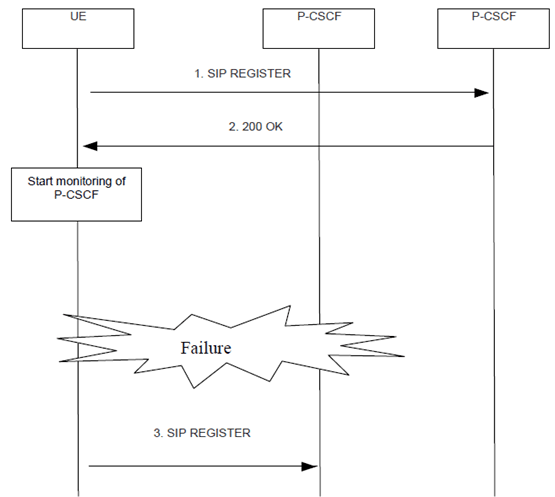Content for TS 23.380 Word version: 18.1.0
5.2 Inform UE about P-CSCF failure
5.3 Network recovery information flow - UE uses keep alive mechanism
...
...
5.2 Inform UE about P-CSCF failure p. 19
These flows show the procedures performed by the network at P-CSCF failure after user initiated registration..
5.2.1 General requirements p. 19
The following points are considered as requirements for the purpose of these procedures.
- P-CSCF discovery is performed by requesting P-CSCF address(es) via DHCP method, as specified in clause 13a.2.1 of TS 29.061.
- The UE supports PCO IE, as specified in clause 10.5.6.3 of TS 24.008.
- For the GTP based S5 interface, GTPv1, as specified in TS 29.060 or GTPv2, as specified in TS 29.274 are supported by the GGSN/PDN-GW
- For the PMIPv6 based S5 interface, PMIPv6, as specified in TS 29.275 is supported by the PDN-GW.
5.2.2 Network recovery information flow - Inform UE at P-CSCF failure p. 19

Step 1-2.
The UE initiates an IP-CAN session.
Step 3.
P-CSCF discovery is performed using DHCP based method. The GGSN/PDN-GW relays/send the list of P-CSCF addresses in DHCP response.
Step 4.
The GGSN/PDN-GW sends CCR to request for PCC rules, as specified in TS 29.212.
Step 5.
The PCRF provides PCC rules to be applied in CCA.
Step 6.
The UE performs an initial registration towards the P-CSCF received.
Step 7.
The P-CSCF sends Rx Push (see TS 29.214) to provide the PCRF with the P-CSCF selected by the UE,
Step 8.
The PCRF sends Rx Push reponse.
Step 9.
The PCRF uses a Gx push procedure to provide the GGSN/PDN-GW with the P-CSCF address.
Step 10.
The GGSN/PDN-GW stores this address for the UE and sends Gx Push Rsp. Also, the GGSN/PDN-GW starts monitoring the health of the P-CSCF if not already done.
Step 11.
The P-CSCF sends 200 OK to the UE.
Step 12.
A failure in P-CSCF is detected via Gi/sGi by the GGSN/PDN-GW. The GGSN/PDN-GW informs to all UEs associated to the failed P-CSCF address that the P-CSCF is not available.
Step 13.
The UEs acknowledge the request.
Step 14.
The UE requests P-CSCF addresses (if needed) via new DHCP request.
Step 15.
The UE selects a new P-CSCF and initiates an initial IMS registration.
5.2.3 Network recovery information flow - Inform UE at P-CSCF failure with S5 PMIP |R11| p. 21

Figure 5.2.3-1: P-CSCF failure for DHCP based scenarios with S5 PMIP
(⇒ copy of original 3GPP image)
(⇒ copy of original 3GPP image)
Step 1 ~ 11.
Same as Figure 5.2.2a step 1 ~ 11
Step 12.
A failure in P-CSCF is detected via Gi/sGi by the GGSN/PDN-GW. The GGSN/PDN-GW informs to all UEs associated to the failed P-CSCF address that the P-CSCF is not available.
Step 13 ~ 15.
- The PDN-GW shall send a PMIP UPN message (MN ID, APN, PDN connection ID, PCO, and Additional parameters) as specified in TS 29.275 and RFC 7077. The PCO contains a P-CSCF failure Indicator. The Notification reason shall indicate that there is a P-CSCF failure.
- If the SGW supports the PMIP Update Notification message, it shall send Update Bearer Request message with the P-CSCF failure Indicator in the PCO to the MME as part of the PGW initiated bearer modification without QoS update procedure as specified in TS 23.401. Once the Update Bearer Response message is received, the SGW shall response with a PMIP UPA message (MN ID, APN, PDN connection ID, PCO, and Additional parameters) as specified in TS 29.275 and RFC 7077.
- If the PGW knows the SGW does not support the PMIP Update Notification procedure, the PGW may release the PMIP binding with cause code "Reactivation Requested".
Same as Figure 5.2.2a step 13 ~15.
5.3 Network recovery information flow - UE uses keep alive mechanism p. 22

Step 1.
After establishment of an IP-CAN session and acquiring P-CSCF addresses, the UE performs initial registration towards a P-CSCF.
Step 2.
If registration is successful, the UE monitors the P-CSCF health according to RFC 6223
Step 3.
When a failure is detected, the UE acquires new P-CSCF addresses (if needed) and performs an initial registration.